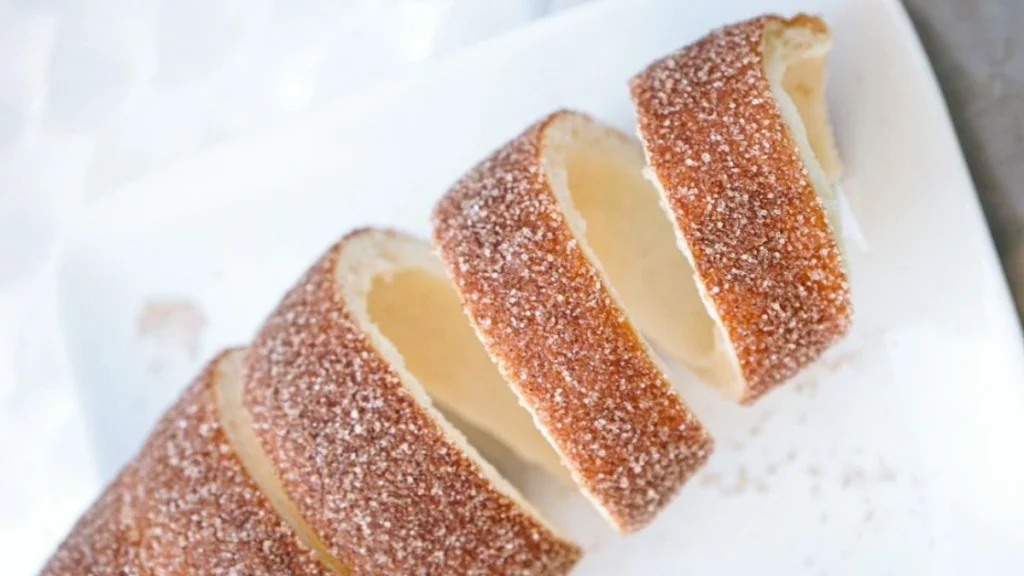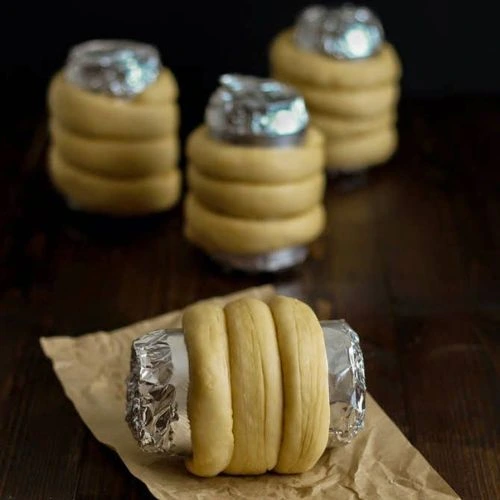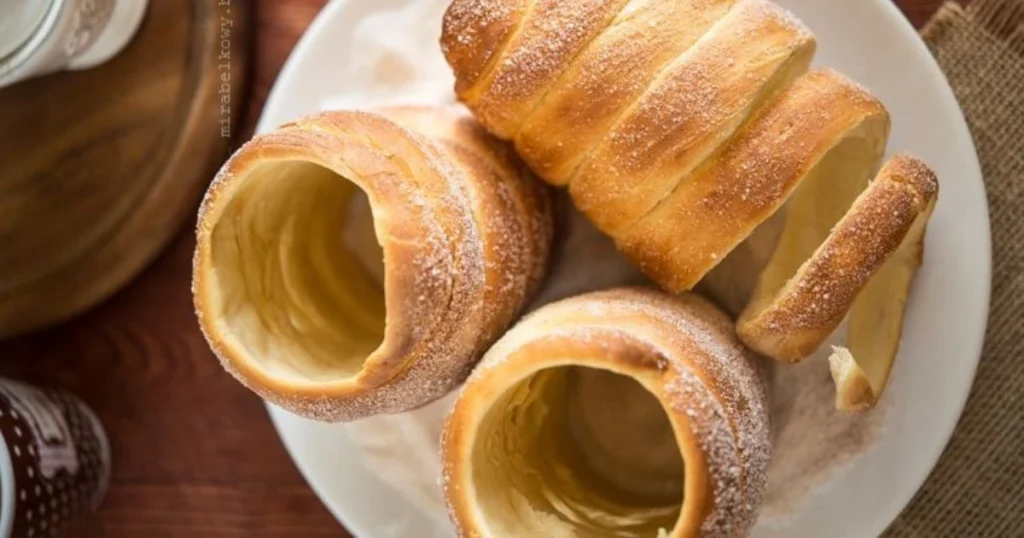Table of Contents
Ready to explore the world of Hungarian cuisine? The kürtőskalács, or Hungarian Chimney Cake, is a must-try. It’s known for its spiral shape, crispy outside, and soft inside. This pastry is a favorite in Hungary and loved globally for its unique taste and texture.

Key Takeaways
- Discover the authentic recipe and traditional preparation method for Hungarian Chimney Cake
- Learn about the rich cultural significance and historical evolution of this iconic pastry
- Understand the essential ingredients and specialized equipment required for baking the perfect chimney cake
- Master the art of rolling and shaping the dough to achieve the signature spiral design
- Explore a variety of sugar coatings and flavor variations to customize your chimney cake experience
What Is Hungarian Chimney Cake and Its Origins
The Hungarian chimney cake, or kürtőskalács, is a favorite dessert in Transylvania. It’s known as a “spit cake” and has a deep history in Hungary. This pastry is loved by many.
Traditional Significance in Hungarian Culture
The kürtőskalács is dear to Hungarians. It’s a treat enjoyed at special times like weddings and birthdays. Its chimney-like shape symbolizes Hungarian culture and pride.
Historical Evolution of the Recipe
The kürtőskalács started in Transylvania, baked on a spit over an open fire. The recipe has changed over time, but its core remains the same. Today, it comes in various flavors but keeps its unique shape and caramelized outside.
Why It’s Called Chimney Cake
The name “chimney cake” comes from its chimney-like shape. As it’s baked on a spit, it gets this distinctive form. It’s a highlight of Hungarian cuisine and a must-try for visitors.
Essential Ingredients for Perfect Chimney Cake
Making a real Hungarian chimney cake needs the right mix of top-notch ingredients. From the yeast dough to the sugar coating, each part is key. They all work together to give the cake its unique taste and feel. Let’s look at what you need to make a chimney cake that’s truly special.
The yeast dough is at the heart of the cake. It’s made with flour, yeast, sugar, and warm milk or water. This mix makes a soft, slightly sweet base that’s easy to roll and shape. Adding eggs and butter makes the dough tender and rich. A little salt helps balance the flavors.
The sugar coating is the next important step. Hungarian chimney cakes are often coated in sugar and vanilla flavoring. This mixture caramelizes when baked, making the outside golden and crisp. Some recipes also add cinnamon or other spices to boost the flavor.
By carefully choosing and mixing these ingredients, you can bring out the true taste of the Hungarian chimney cake. Your taste buds will thank you for this authentic treat.
Required Tools and Equipment for Baking
To bake the perfect Hungarian chimney cake, you need specific tools. Traditional methods use open-fire cooking. But, modern baking uses advanced tools for better results. Let’s look at what you need to make this tasty pastry.
Traditional vs. Modern Baking Methods
Before, chimney cakes were cooked over an open fire. Bakers used a metal spit or a wooden roller. This method needed skill and patience to get even browning. Now, many prefer electric or gas ovens for easier baking.
Chimney Cake Roller Types
- Wooden Roller: This traditional tool shapes the cake into a cylinder. It makes the dough even.
- Metal Spit: Some use a metal spit like a rotisserie. It cooks the dough evenly over an open flame.
- Electric Chimney Cake Maker: This modern appliance rolls and bakes the cake. It’s great for home cooks.
Temperature Control Equipment
Temperature control is key, no matter the baking method. Home bakers need:
| Equipment | Purpose |
|---|---|
| Oven Thermometer | Ensures accurate temperature readings for consistent baking. |
| Temperature Probe | Helps monitor the internal temperature of the chimney cake during baking. |
| Infrared Thermometer | Allows for quick surface temperature checks to gauge the cake’s doneness. |
With the right tools, you can bake delicious Hungarian chimney cakes at home. You can use traditional or modern methods.
Step-by-Step Dough Preparation
Making the perfect kürtőskalács (Hungarian chimney cake) begins with dough preparation. This step is key to a delicious and true-to-recipe final product. Let’s explore how to prepare the kürtőskalács dough, from activating the yeast to mastering the kneading technique.

To start, activate the yeast. Combine warm water, sugar, and active dry yeast in a small bowl. Stir gently and wait for 10 minutes, until it’s frothy and bubbly. This step is crucial to make sure the yeast is active and ready to work in the dough.
- In a large mixing bowl, mix the yeast mixture with flour, salt, and melted butter or oil. Knead the kürtőskalács dough until it’s smooth and elastic, about 5-7 minutes.
- When kneading, use gentle yet firm pressure. Fold and stretch the dough to build its gluten structure. This makes the dough pliable and easy to shape.
- Once kneaded, cover the dough and allow it to rest for at least 30 minutes. This allows the gluten to relax and the flavors to meld.
Now that the kürtőskalács dough is ready, you can move on to the next step. This is the traditional rolling and shaping technique. We’ll dive into this exciting process next.
Mastering the Hungarian Chimney Cake Rolling Technique
Making the perfect Hungarian chimney cake is all about mastering dough wrapping. The secret to getting that iconic spiral shape and even coating is in your rolling technique. Let’s explore the details to help you get this essential step right.
Proper Dough Thickness
The right dough thickness is key for chimney cake perfection. It should be thin enough to wrap smoothly around the roller but not too thin. Aim for a dough thickness of around 1/8 to 1/4 inch. This ensures your cake is fluffy inside and crispy outside.
Coating Application Methods
- For an even dough wrapping, gently roll the dough onto the chimney cake roller, taking care to maintain a consistent spiral shape.
- Once the dough is wrapped, it’s time to apply the coating. Traditional methods involve brushing or drizzling the dough with melted butter or oil, followed by a generous sprinkle of your desired toppings, such as sugar or cinnamon.
- For a more uniform even coating, you can also try dipping the entire wrapped dough into the butter or oil mixture, ensuring every nook and cranny is coated before adding the toppings.
With a bit of practice and focus on detail, you’ll soon be rolling and coating your chimney cakes like a pro. The trick is to find the technique that works best for you and consistently make those irresistible, spiral-shaped treats.
Sugar Coating and Flavor Variations
Getting the caramelized sugar coating right is crucial for a true Hungarian chimney cake. Roll the dough in sugar to spread it evenly. As it bakes, the sugar melts, making the cake’s outside golden and crisp.
There are many ways to flavor your chimney cake. Try adding cinnamon to the sugar for a warm, sweet taste. It pairs well with the cake’s buttery flavor.
For a chocolatey treat, coat the dough with melted chocolate. Use dark or milk chocolate for a rich taste. You can also fill it with Nutella or fruit preserves for extra indulgence.
Playing with toppings and coatings is fun. Add nuts for crunch or try citrus zest or vanilla for new tastes. The options are endless, making your chimney cake unique.

Baking Temperature and Timing Guide
To get your Hungarian chimney cakes just right, you need to control the temperature and time. Knowing the best baking conditions is key. Also, watching for visual signs will tell you when they’re done perfectly.
Signs of Perfect Doneness
Keep a close eye on your chimney cakes as they bake. Here are the signs they’re done:
- A deep, golden-brown color that evenly coats the entire surface
- A crispy, crunchy exterior that gives way to a soft, fluffy interior
- The aroma of caramelized sugar and freshly baked dough wafting through the kitchen
Common Baking Mistakes to Avoid
While baking chimney cakes seems easy, there are common mistakes to avoid:
- Uneven Baking: Rotating the cakes during baking is key for even color.
- Overcooking: Watch them closely to avoid them getting too crispy or burnt.
- Undercooking: Not baking long enough can make the inside doughy. Stick to the recommended time.
| Baking Temperature | Baking Time |
|---|---|
| 375°F (190°C) | 20-25 minutes |
Mastering the baking time and temperature, and watching for the right signs, will help you make authentic Hungarian chimney cakes. They’ll be golden-brown, crispy on the outside, and soft on the inside every time.
Serving and Storage Tips
Freshly baked Hungarian chimney cakes, also known as kürtőskalács, are a delightful treat to savor. When serving these delectable desserts, consider presenting them in an eye-catching manner. Display the golden, spiral-shaped cakes on a platter or tiered stand to showcase their unique appearance. Sprinkle a light dusting of powdered sugar or cinnamon over the top for an added touch of elegance.
To maintain the fresh, crisp texture of your chimney cakes, proper storage is essential. After cooling, place the cakes in an airtight container and store them at room temperature. This will help preserve the flaky exterior and soft, tender interior. If you need to reheat the cakes, simply place them in a preheated oven for a few minutes until warmed through and the sugar coating is lightly caramelized.
For long-term storage, you can freeze the chimney cakes. Individually wrap them in plastic wrap or aluminum foil, then store them in a freezer-safe bag or container. When ready to enjoy, thaw the cakes at room temperature and then reheat them in the oven to restore their freshness and crispness.
FAQ
What is Hungarian Chimney Cake?
Hungarian Chimney Cake, also known as Kürtőskalács, is a traditional pastry. It has a spiral shape and a crispy, caramelized outside. The inside is soft and tender. This sweet treat is loved in Hungary and has become popular worldwide.
What is the traditional significance of Chimney Cake in Hungarian culture?
Chimney Cake has a long history in Hungarian culture. It comes from the Transylvanian region. It’s a beloved treat in Hungarian celebrations and gatherings.
What are the essential ingredients for making authentic Hungarian Chimney Cake?
To make a traditional Hungarian Chimney Cake, you need flour, yeast, sugar, eggs, butter, and vanilla. Using fresh, high-quality ingredients is key for the best flavor and texture.
What kind of tools and equipment are required for baking Chimney Cake?
You’ll need a chimney cake roller or spit and temperature control devices to bake Chimney Cake. Both traditional open-fire methods and modern oven techniques are used.
How do you properly prepare the Chimney Cake dough?
To prepare the dough right, activate the yeast, mix the ingredients, and knead it. This ensures the dough has the right consistency and texture.
What is the key to mastering the Chimney Cake rolling technique?
Rolling the dough to the right thickness is key for the spiral shape. Also, coat it evenly for a consistent look.
What are the different sugar coating and flavor variations for Chimney Cake?
Chimney Cake can have different coatings like caramelized sugar, cinnamon, cocoa, nuts, or even Nutella. There are many flavor options.
What is the optimal baking temperature and timing for Chimney Cake?
The right temperature and timing are crucial for baking Chimney Cake. Watch for visual cues to get a crispy outside and soft inside.
How should Chimney Cake be served and stored?
Serve Chimney Cake warm for the best experience. Store it properly to keep it fresh and prevent drying out.

